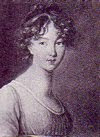
Serving Girl Knitting
Attributed to André Bouys (French, 1656–1740)
Oil on canvas 36 1/4 x 28 1/2 in. (92.1 x 72.4 cm)
Mr. and Mrs. Isaac D. Fletcher Collection, Bequest of Isaac D. Fletcher, 1917 (17.120.211)
Metropolitan Museum of Art, New York, New York
I have written about this painting before (http://historyknits.blogspot.com/2008/03/knitting-in-art.html) I like the it very, very much, not only because of the knitting but for the details of 18th century clothing. The image of it from the Met’s site was, at that time, however, small and only available in black and white which not only did not let us clearly see the fabrics’ colors and textures but also hid the fourth needle from my eyes on my laptop’s small screen. T he current image from the Met's site, used here, is now much sharper. In an effort, though, a few years ago, to get what I hoped would be a better version of the image, I ordered an electronic version of the painting directly from the Met or, rather, the linked service which provides such things. I cannot legally use that image on this blog so the images here are, again, from the Met’s regular Internet site*, including the section showing the knitting.
The “ordered” image, although also in black and white, is, however, richer in the details of the painting. I can now see the beautiful cap and handkerchief of the sitter as well as a huge ball of wool on the table next to a basket containing a work bag with striped ribbons. Both of these items previously looked like food to me in the smaller image on the Met’s Internet site and I was wondering about that dangling thread from the table. With the zoom feature, I can get an even better look at them and hope to reproduce the work bag at some future time. I was also amused by the size of the ball of wool as it is larger than most in most paintings from that and the surrounding centuries.
Most exciting of all was the fourth needle. It lies against the girl’s inner arm where, thin and bent, in the smaller image, it had looked like a crease in her sleeve if it could be seen at all in that older image from the Met’s site. The girl has just started a new row with it so it is largely empty, perhaps only holding a few stitches which are covered by the hand clutching the knitting. What is, though, the curious curl at or near the end of the needle? A wrinkle in her clothing or something attached to her clothing – a part of something similar to a chatelaine?
Oh, dear – a needle found but another mystery, too.

*http://www.metmuseum.org/works_of_art/collection_database/european_paintings/a_serving_girl_knitting_attributed_to_andre_bouys/objectview_enlarge.aspx?page=26&sort=0&sortdir=asc&keyword=&fp=1&dd1=11&dd2=0&vw=1&collID=11&OID=110000323&vT=1&hi=0&ov=0


7 comments:
The curly bit looks like it's attached to the curved needle. A mystery - or a non-knitting artist :-)
I wonder if the curve is part of a key hoop/chatelaine and the reason that she is looking slightly cross is that she has just dropped her fourth needle but is unable to pick it up because M. Bouys has told her not to move because he is doing her nose.
Thanks for another interesting post.
Anna
That's the top of the (usually carved wooden) knitting stick.
The fourth needle is stuck into it. She manipulates the needle by bending it with her right forearm, puts it through a stitch and puts a loop around the tip with her fingers, then the needle's own springiness pulls the yarn loop through. This allows for very fast work. Thank you for finding a clear picture of a knitting stick in use! I learned about this technique on "A Fisherman Knits".
Seconding what Tamar said - it's a knitting stick or sheath of some kind.
Mary Thomas has pictures of different kinds of these in her Knitting Book.
Thank you, everyone, for your comments.
A knitting stick - why didn't I think of that? I only have one glaring at me from its box across the room as I write!
I think she looks cross, too, perhaps because this is her time to relax and knit and the artist wants her to pose instead! She or someone else may also need whatever she is knitting (looks like a stocking) so she would like to get on with it.
I use a knitting sheath for 18th C fine knitting. The curve of the 4th needle under tension from the stick matches that I get seems to match this painting neatly.
Also, I'm noticing that the girl is not currently wearing stays, although she seems to have some support, so I'm wondering if she had jumps on. And her posture suggests that she is used to stays, because her arms are fairly far back.
Thank you for the information about this painting--it is one of my favorites and I have used it on the home page of F&I Women.
Post a Comment